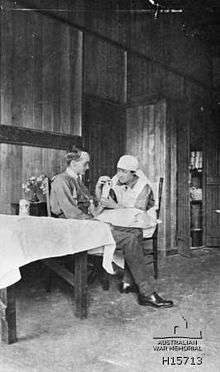Arthur Wesley Wheen
| Arthur Wheen | |
|---|---|
 Lieutenant Wheen at a hospital in England, c.1918 | |
| Born |
9 February 1897 Sunny Corner, Australia |
| Died |
15 March 1971 (aged 74) Buckinghamshire, England |
| Allegiance | Australia |
| Service/branch | Australian Imperial Force |
| Years of service | 1915–1919 |
| Rank | Lieutenant |
| Battles/wars | First World War |
| Awards | Military Medal & Two Bars |
| Other work | Librarian and translator |
Arthur Wesley Wheen, MM & Two Bars (9 February 1897 – 15 March 1971) was an Australian soldier, translator and museum librarian. He is best known for translating the work of Erich Maria Remarque into English, beginning with the classic war novel All Quiet on the Western Front in 1929.
Early life and education
He was the son of Clara and Harold Wheen, who was a Wesleyan Minister. His father was transferred to Sydney in 1910, where young Arthur attended Gordon Public School and Sydney Boys High School. In 1915, he won admission to Sydney Teachers College and later attended the University of Sydney, where he studied the fine arts.[1]
First World War
Shortly after turning eighteen, he decided to enlist in the Australian Imperial Force and, soon thereafter, was posted to Egypt where he served as a signaller for the 54th Battalion at a military base near the Tel-el-Kebir. The next year saw him reassigned to the front, in France.[1]
In July 1916, he was awarded the Military Medal (MM) for braving enemy artillery barrages to repair telephone lines and maintain communications.[2] Later, two bars would be added to his medal, one at Beaulencourt in 1917 and the second at Villers-Bretonneux in 1918. He was one of only fifteen Australians to receive this honour.[2] He rose through the ranks quite rapidly, receiving a promotion to Lance Corporal in January 1918 and then to Corporal only one week later. He was then recommended to an officers' training course in Oxford, which he attended, and was commissioned a Lieutenant in August. Having been wounded twice (in 1917 and 1918) he was finally sent back home to Sydney, on a disability, in 1919.[1]
Later years
He promptly returned to Sydney University to complete his studies. In 1920, he was awarded a Rhodes Scholarship and left Australia to study Modern History at New College, Oxford, graduating in 1923. He was soon able to secure a position at the Victoria and Albert Museum, where he was appointed "Keeper of the Library" in 1945, remaining in that post until his retirement in 1962.[1] In his later years, he dabbled in etching and pottery, as well as writing the occasional magazine article.
Translations

In 1929, when Erich Maria Remarque published Im Westen Nichts Neues, Wheen was quick to read it and compare it with his own experiences, which prompted him to do a translation, rendering the title as All Quiet on the Western Front. It received excellent reviews and is still considered to be the standard English version of that work. He went on to translate two more novels by Remarque: Der Weg Zurück (The Road Back, 1931) and Drei Kameraden (Three Comrades, 1937).
His other translations from the German include: Four Infantrymen by Ernst Johanssen (1930); The Kaiser Goes: The Generals Remain by Theodor Plivier (1933) and Virgil, Father of the West by Theodor Haecker (1934).[3]
His only original work was a novella, Two Masters, first published in the London Mercury in November 1924.
References
Bibliography
- We Talked of Other Things: The Life and Letters of Arthur Wheen 1897–1971, edited by Tanya Crothers. Woollahra, N.S.W.: Longueville Media (2011) ISBN 978-0-9870570-1-3
External links
- The Wheen papers in the National Library of Australia
- Etching of Wheen by Edgar Holloway (1914–2008) in the National Portrait Gallery